Panic of 1921 Spawned Famous Coins
The year 1921 is very important to many collectors of classic U.S. coins of the 20th century.
The year 1921 is very important to many collectors of classic U.S. coins of the 20th century. Several coin issues of 1921 are relatively scarce now, largely because of the severe recession of 1920–21. High unemployment rates, sharp deflation, an economic contraction and the brutal suffering of farmers lead to nationwide distress and caused many to panic in 1921.
If not for the recession of 1920–21, mintages for several coin issues in 1921 would have been much higher and it is likely that more people would have saved coins that were then current. People under economic duress are less likely to actively collect coins or put coins aside for other reasons.
It would be an exaggeration to say that all 1921, 1921-D and 1921-S coins are keys or semi-keys. Several are so, and many presently famous coins were struck this year. More so than any other single year of the 20th century, key dates and semi-keys were minted during 1921. The severe recession of 1920 and 1921 reduced the demands for coins in commerce and thus less production occurred in regard to all denominations that were struck in 1919 and 1920. Silver dollars were made in 1921 for political reasons far apart from the economic disaster that adversely affected a large number of U.S. citizens.
To form an impression as to why people were panicking in 1921, it helps to think about food and farming. More than ten times the percentage of the labor force was involved in farming in 1920 than was involved in 2020, perhaps more than fifteen times. In 1920, a large chunk of the U.S. population made a living via farming; only a very small percentage does now.
According to data published by the U.S. census bureau, the net income of farmers from farming was $9,078,000,000 in 1919, $7,795,000,000 in 1920 and just $3,370,000,000 in 1921. The nominal net incomes of farmers fell by 14% from 1919 to 1920 and then by more than 50% from 1920 to 1921 (https://tinyurl.com/farming1920). The average net income per farm decreased by even more than 50% from 1920 to 1921!
Businesses with large inventories of various products, not just food, suffered terribly, too. According to the U.S. Bureau of Labor Statistics, prices fell by 16% from June 1920 to June 1921 (https://tinyurl.com/PriceLevelCalc).
Nationwide, the unemployment rate peaked at 11.7 percent in 1921. Gross National Product (GNP) statistics that were adjusted for deflation and published by the U.S. census bureau show an 8.7% real drop in annual output from 1920 to 1921 (https://tinyurl.com/GNP1869to1970). The steep declines in the values of goods, land and businesses in combination with rising unemployment and decreases in output caused many people to panic.
Although this recession ended late in 1921, its effects on coinage have been felt by coin collectors ever since. Indeed, coin collectors have been enthusiastic about pursuing key dates and semi-keys that were spawned by this recession.
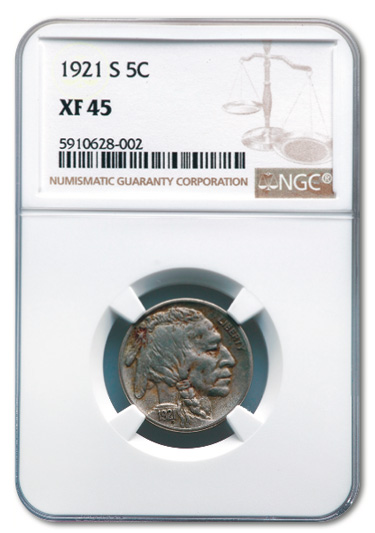
While 1921 and 1921-S Lincoln cents are better dates, certainly scarcer
than corresponding issues of 1920, they are not keys or semi-keys. Lincoln
cents are not the best examples of the theme here. Buffalo nickels are more
relevant.
In Extremely Fine (XF40) grade, the CPG® price estimate at press
time for a 1921 Buffalo nickel is $54. It is illuminating to compare this
number to the CPG® prices for other Philadelphia mint nickels in
XF40 grade; 1915 ($16), 1916 ($11),
1917 ($14), 1918 ($23), 1919 ($14), 1920 ($15), 1923 ($14), 1924 ($22),
1925 ($20), and 1926 ($11). In XF40 grade, a 1921 nickel is worth multiples
of the others.
The 1921-S commands a substantial premium over most other San Francisco Mint dates in the series of Buffalo nickels. The 1924-S and the 1926-S are semi-keys, which are considered to be more important than the 1921-S. The 1926-S is an extreme condition rarity in gem grades. In XF40 grade, however, the 1921-S ($780) is estimated to be worth more than the 1924-S ($748) and the 1926-S ($682).
The CPG® estimate for an XF40 grade 1919-S is $247 and the CPG estimate for a 1920-S is $195, one-fourth the value of a 1921-S! No Buffalo nickels were minted in 1922 at any mint. An XF40 grade 1923-S is estimated to be worth $234, less than one-third of the CPG® value for an XF40 grade 1921-S!
Nearly ten million 1920-S nickels were minted and more than six million 1923-S nickels. If there was not a 1920–21 recession, would six to ten million 1921-S nickels have been minted, rather than just around one and a half million?
It is likely that the 1920–21 recession severely affected production of Mercury dimes. In Philadelphia, more than fifty-nine million dimes were produced in 1920 yet only 1,230,000 in 1921, a decrease of about 98%!
At the Denver Mint, more than nineteen million dimes were struck in 1920, though barely more than one million 1921-D dimes were minted. Although nearly fourteen million 1920-S dimes were released, the San Francisco Mint did not strike dimes again until 1923 and just 6,440,000 1923-S dimes were minted.
In XF40 grade, 1917, 1920, 1923, 1925, 1926, 1927, 1928, 1929, 1929-D, and 1929-S dimes each have a CPG® value of $6.75. In contrast, an XF40 grade 1921 Philadelphia Mint dime is valued at $488, more than seventy times as much! On March 30, 2021, Heritage sold two NGC graded AU50 1921 dimes, one for $780 and the other for $750.
In circulated grades, the 1921-D dime is scarcer and more valuable than the 1921 Philadelphia Mint issue. It is interesting to compare CPG® values for XF40 grade Denver Mint dimes from the same time period: 1919-D ($47.25), 1920-D ($24.30), 1921-D ($650!), 1924-D ($61), 1925-D ($135), and 1926-D ($32.40).
On August 24, 2021, Stack’s-Bowers sold an NGC graded XF40 1921-D dime for $576 and a PCGS graded XF45 1921-D for $900. The CPG® value for an XF45 1921-D is $845. CPG® prices are for guidance. Individual coins really need to be examined in actuality to be properly evaluated.
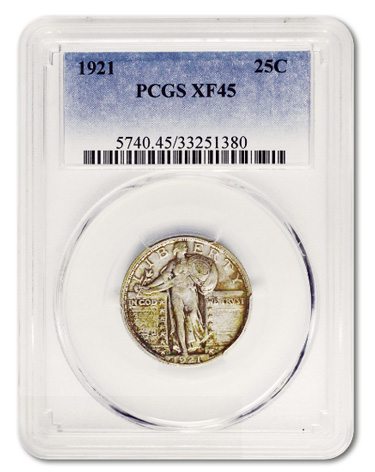
Originality, color, luster and striking detail all vary from coin to coin.
For example, it is often true that two Standing Liberty quarters of the
same date and grade will appear very different. Striking detail, surface
texture and toning tend to be particularly inconsistent among surviving
Standing Liberty quarters. CPG® price guide values are employed
here to illustrate relative retail prices, not to draw conclusions about
the values of specific coins.
In the series of Standing Liberty quarters, the 1921 is clearly a semi-key! There are no 1921-D or 1921-S quarters. In XF40 grade, the 1921 is worth far more than other Philadelphia Mint quarters from 1918 to 1925: 1918 ($43), 1919 ($88), 1920 ($54), 1921 ($754), 1923 ($57), 1924 ($49) and 1925 ($54). On Aug. 10, 2020, Stack’s-Bowers auctioned a PCGS graded XF45 1921 quarter for $660.
While 1921 quarters are extremely important, 1921 is really ‘the year of the Walker’! In terms of scarcity and media attention, 1921, 1921-D and 1921-S Walkers tower above all other Walking Liberty half dollars and are famous overall. In the whole series of Walkers, these three are the only dates that are estimated to retail for more than $2,000 each in XF40 grade. Indeed, only one other date has a CPG® value above $1,000 in XF40 grade, the 1919-D.
In 1921, half dollars and silver dollars were the only denominations that were struck at all three mints. Morgan silver dollars were minted in substantial quantities in 1921 and survive in large numbers, due to peculiar political reasons, which should really be the topic of a separate discussion. Silver dollars were not minted from 1905 to 1920. A law passed in 1918 required that large quantities of silver dollars in government vaults be melted. In any event, 1921, 1921-D and 1921-S Morgans are common, inexpensive and easy to find.
Though not now as common as 1921 Morgans, more than twenty-eight thousand 1921 Peace dollars survive. These were struck in late December after the 1920–21 recession was over.
The severe recession of 1920–21 probably does not relate to quarter eagles ($2.5 gold coins) or half eagles ($5 coins) either. After 1915, quarter eagles were not minted again until 1925. After 1916, half eagles were not minted again until 1929!
The minting history of eagles is even more puzzling, though may very well have been affected by the recession of 1920–21. Eagles were minted in Philadelphia and San Francisco in 1915, but only in San Francisco in 1916 and 1920. Other than the 1920-S, there were no eagles minted between 1916 and 1926. Regarding With Motto $10s (1908–33), the 1920-S eagle is one of three rare dates.
The recession of 1920–21 may have been unrelated to the decision to produce 1920-S eagles, though may have affected the mintage of 1920-S eagles and the decision to not mint eagles in 1921. Moreover, this recession is very likely to be relevant to the current rarity of 1920-S eagles. If the economy had been faring better in 1920 and 1921, a larger portion of the mintage would have been set aside by collectors and kept as parts of the personal savings of non-collectors. Savings rates usually fall during recessions.
Indian Head eagles were not only of interest to coin enthusiasts; they were valued at $10 each by people who used them for spending and saving. Many classic U.S. coins that were saved by non-collectors long ago later found their way into coin collections.
As with eagles, the San Francisco Mint produced double eagles in 1920. While no eagles were struck at any U.S. Mint in 1921, the Philadelphia Mint struck 1920 and 1921 double eagles.
In the series of Saint-Gaudens double eagles ($20 gold coins), the 1920-S and the 1921 are both semi-keys, which are each worth far more than most of the other dates in this series. In XF40 grade, a 1920-S twenty has a CPG ® value of $18,200 and a 1921 is estimated to be worth $45,000. If there never was a 1920–21 recession, would 1920-S and 1921 Saints now be worth around as much as 1920, 1922, 1922-S, or 1923 Saints, less than $3,000 each in XF40 grade?
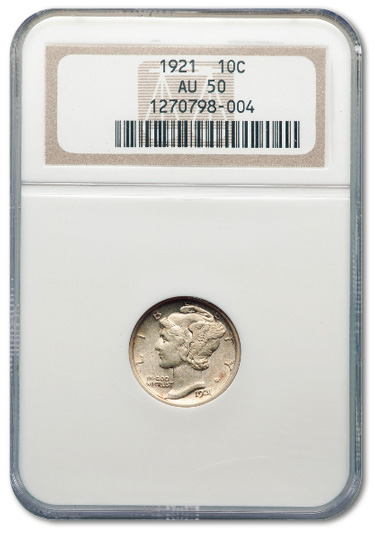
Even though it is impossible to precisely identify the effects of the
1920–21 recession upon coinage and the rarity of pertinent coins in the
present, the coins relating to the 1920–21 recession are historically
significant in an interesting and distinctive way. This recession was very
severe, devastated the agricultural sector and ended without any kind of
government stimulus program. The U.S. economy recovered on its own, and a
long period of tremendous prosperity followed, which ended in 1929.
Regarding the ‘Panic of 1921,’ an idea is to assemble a year set: 1921 and 1921-S Lincoln cents, 1921 and 1921-S nickels, 1921 and 1921-D dimes, a 1921 quarter, three halves, a 1921 Saint, plus three Morgans and a Peace dollar. Such a 1921 set would include famous coins. For collectors of Mercury dimes, Standing Liberty quarters, Walkers and Saints, coins of 1921 are very important topics.
Copyright ©2021 Greg Reynolds
Insightful10@gmail.com.

Download the Greysheet app for access to pricing, news, events and your subscriptions.
Subscribe Now.

Subscribe to RQ Red Book Quarterly for the industry's most respected pricing and to read more articles just like this.
Source: Greg Reynolds
Related Stories (powered by Greysheet News)
View all news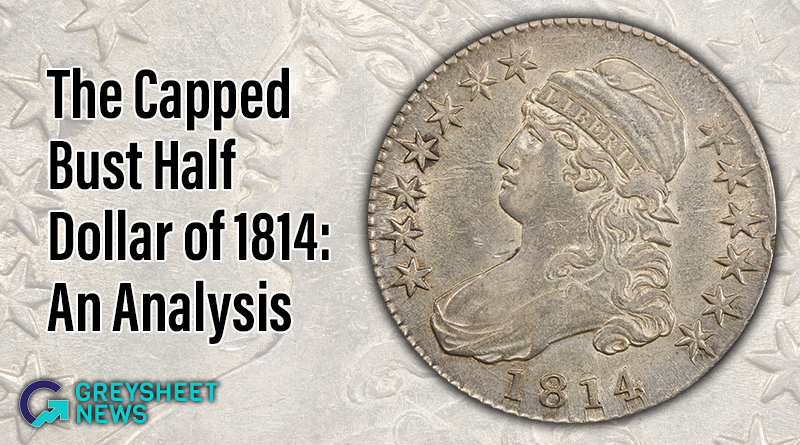
In this article Greg Reynolds analyzes the 1814 Capped Bust Half Dollar.
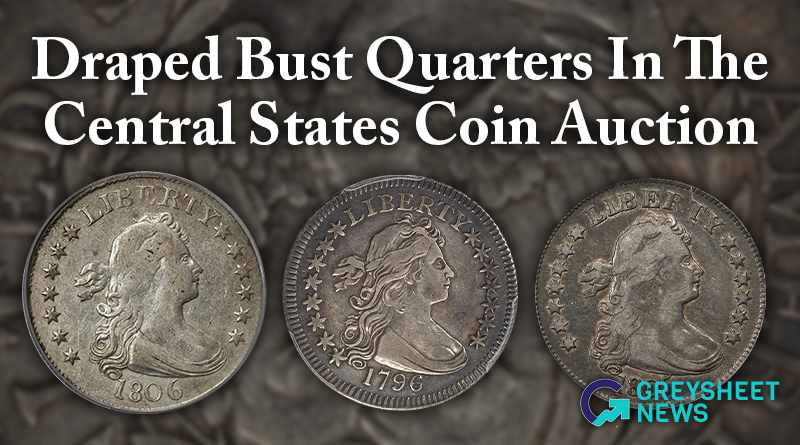
The Lusk set of Draped Bust quarters brought strong results.
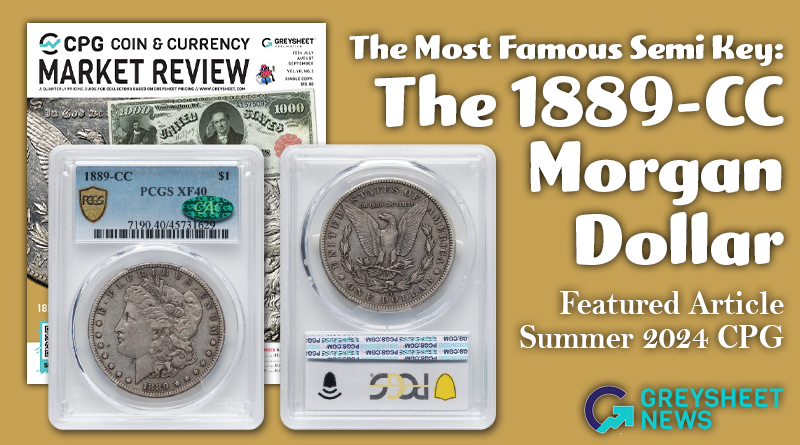
The 1889-CC is the second scarcest business strike in the series.


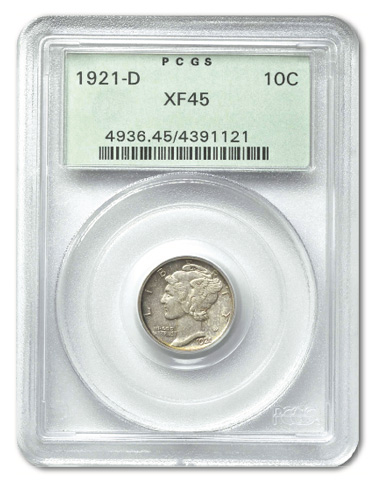






Please sign in or register to leave a comment.
Your identity will be restricted to first name/last initial, or a user ID you create.
Comment
Comments